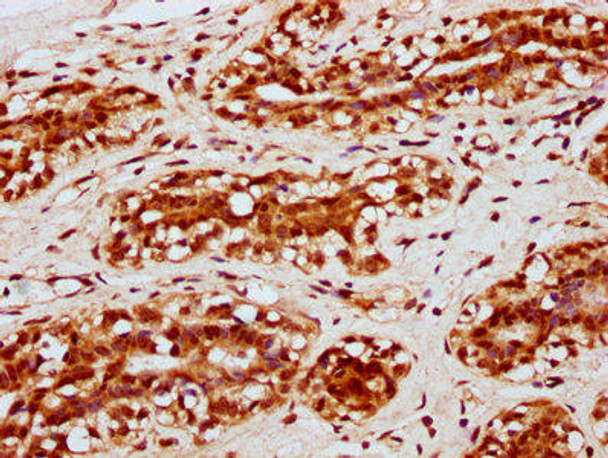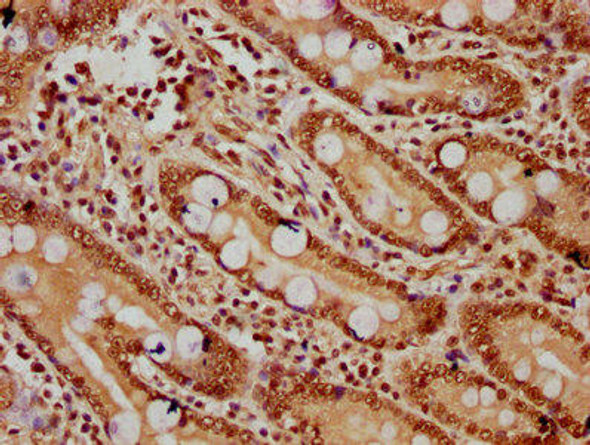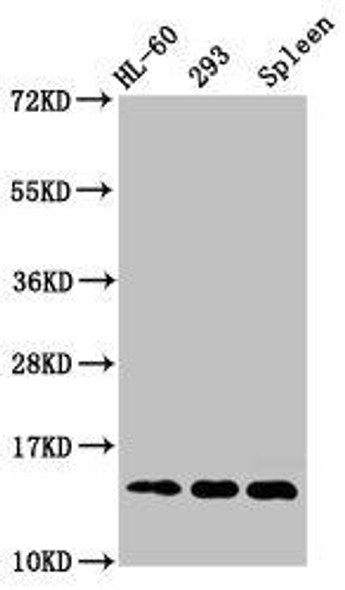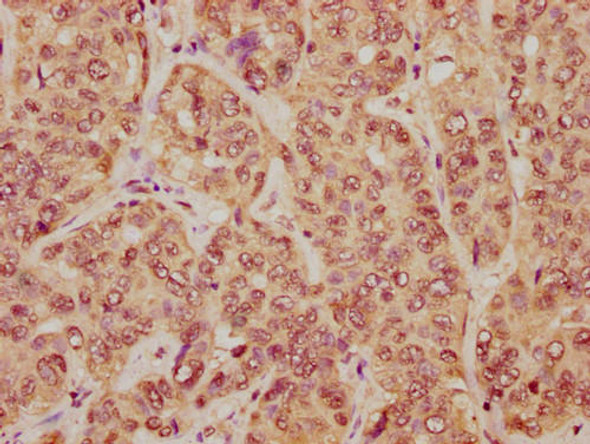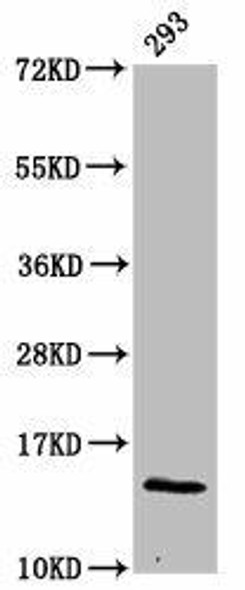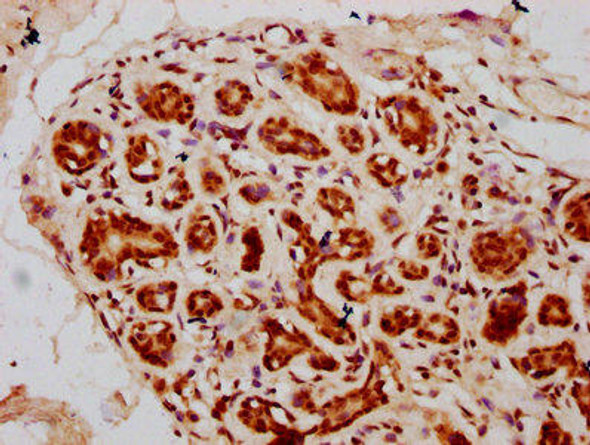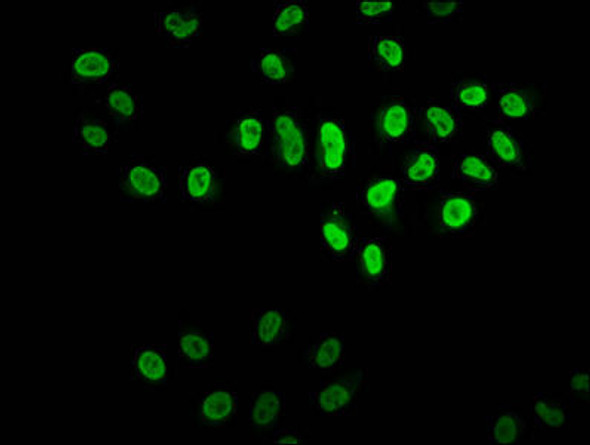Description
HIST1H2BC (Ab-120) Antibody (PACO60634)
The Hist1H2BC Polyclonal Antibody (PACO60634) is a valuable tool for researchers studying Histone H2B variant 1C (Hist1H2BC), a key protein involved in chromatin structure and gene regulation. This antibody, produced in rabbits, exhibits high specificity and sensitivity towards human samples, and has been validated for use in Western blot applications.Histone proteins play a crucial role in packaging DNA into chromatin, thereby regulating gene expression and various cellular processes. Hist1H2BC, a member of the histone H2B family, is involved in maintaining chromatin structure and stability, and its dysregulation has been implicated in various diseases, including cancer and developmental disorders.
By targeting Hist1H2BC with this antibody, researchers can investigate its role in gene regulation, chromatin remodeling, and epigenetic modifications, shedding light on its potential implications in disease pathology and therapeutic targeting. This antibody is a valuable tool for studies in molecular biology, genetics, epigenetics, and cancer research.
| Antibody Name: | HIST1H2BC (Ab-120) Antibody (PACO60634) |
| Antibody SKU: | PACO60634 |
| Size: | 50ul |
| Host Species: | Rabbit |
| Tested Applications: | ELISA, IHC |
| Recommended Dilutions: | ELISA:1:2000-1:10000, IHC:1:10-1:100 |
| Species Reactivity: | Human |
| Immunogen: | Peptide sequence around site of Lys (120) derived from Human Histone H2B type 1-C/E/F/G/I |
| Form: | Liquid |
| Storage Buffer: | Preservative: 0.03% Proclin 300 Constituents: 50% Glycerol, 0.01M PBS, pH 7.4 |
| Purification Method: | Antigen Affinity Purified |
| Clonality: | Polyclonal |
| Isotype: | IgG |
| Conjugate: | Non-conjugated |
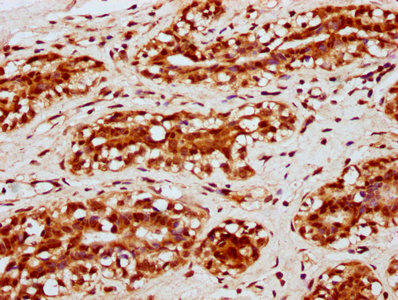 | IHC image of PACO60634 diluted at 1:10 and staining in paraffin-embedded human breast cancer performed on a Leica BondTM system. After dewaxing and hydration, antigen retrieval was mediated by high pressure in a citrate buffer (pH 6.0). Section was blocked with 10% normal goat serum 30min at RT. Then primary antibody (1% BSA) was incubated at 4°C overnight. The primary is detected by a biotinylated secondary antibody and visualized using an HRP conjugated SP system. |
| Background: | Core component of nucleosome. Nucleosomes wrap and compact DNA into chromatin, limiting DNA accessibility to the cellular machineries which require DNA as a template. Histones thereby play a central role in transcription regulation, DNA repair, DNA replication and chromosomal stability. DNA accessibility is regulated via a complex set of post-translational modifications of histones, also called histone code, and nucleosome remodeling. |
| Synonyms: | Histone H2B type 1-C/E/F/G/I (Histone H2B.1 A) (Histone H2B.a) (H2B/a) (Histone H2B.g) (H2B/g) (Histone H2B.h) (H2B/h) (Histone H2B.k) (H2B/k) (Histone H2B.l) (H2B/l), HIST1H2BC; HIST1H2BE; HIST1H2BF; HIST1H2BG; HIST1H2BI, H2BFL; H2BFH; H2BFG; H2BFA; H2BFK |
| UniProt Protein Function: | H2B1C: a core component of the nucleoosome. The nucleosome, a basic organizational unit of chromosomal DNA, is octrameric, consisting of two molecules each of histones H2B, H2A, H3, H4. The octamer wraps approximately 147 bp of DNA. Nucleosomes wrap and compact DNA into chromatin, limiting DNA accessibility to the cellular machineries which require DNA as a template. Histones thereby play a central role in transcription regulation, DNA repair, DNA replication and chromosomal stability. DNA accessibility is regulated via a complex set of post-translational modifications of histones, also called histone code, and nucleosome remodeling. |
| UniProt Protein Details: | Protein type:DNA-binding Chromosomal Location of Human Ortholog: 6p22.1 Cellular Component: cytoplasm; extracellular space; nucleoplasm; nucleus Molecular Function:DNA binding; protein binding Biological Process: antibacterial humoral response; defense response to Gram-positive bacterium; innate immune response in mucosa; nucleosome assembly |
| NCBI Summary: | Histones are basic nuclear proteins that are responsible for the nucleosome structure of the chromosomal fiber in eukaryotes. Nucleosomes consist of approximately 146 bp of DNA wrapped around a histone octamer composed of pairs of each of the four core histones (H2A, H2B, H3, and H4). The chromatin fiber is further compacted through the interaction of a linker histone, H1, with the DNA between the nucleosomes to form higher order chromatin structures. The protein has antibacterial and antifungal antimicrobial activity. This gene is intronless and encodes a replication-dependent histone that is a member of the histone H2B family. Transcripts from this gene lack polyA tails; instead, they contain a palindromic termination element. This gene is found in the large histone gene cluster on chromosome 6p22-p21.3. [provided by RefSeq, Aug 2015] |
| UniProt Code: | P62807 |
| NCBI GenInfo Identifier: | 290457686 |
| NCBI Gene ID: | 8339 |
| NCBI Accession: | P62807.4 |
| UniProt Secondary Accession: | P62807,P02278, Q3B872, Q4VB69, Q93078, Q93080, |
| UniProt Related Accession: | P62807 |
| Molecular Weight: | 13,906 Da |
| NCBI Full Name: | Histone H2B type 1-C/E/F/G/I |
| NCBI Synonym Full Names: | histone cluster 1, H2bg |
| NCBI Official Symbol: | HIST1H2BG |
| NCBI Official Synonym Symbols: | H2B/a; H2BFA; H2B.1A; dJ221C16.8 |
| NCBI Protein Information: | histone H2B type 1-C/E/F/G/I |
| UniProt Protein Name: | Histone H2B type 1-C/E/F/G/I |
| UniProt Synonym Protein Names: | Histone H2B.1 A; Histone H2B.a; H2B/a; Histone H2B.g; H2B/g; Histone H2B.h; H2B/h; Histone H2B.k; H2B/k; Histone H2B.l; H2B/l |
| Protein Family: | Histone |
| UniProt Gene Name: | HIST1H2BC |
| UniProt Entry Name: | H2B1C_HUMAN |

